69. The text in
Manuscript E follows the events of Makoi (Saturn) from
Maro 15 (166 + 365 = 531 = 18 * 29½) to Anakena 5 when all
the Explorers together went downhill and
returned to Hanga Te Pau.
| MAY 20
(140) |
21 (*61) |
22 |
23 |
24 (144) |
13 |
 |
 |
 |
 |
 |
| Ga3-1
(60) |
Ga3-2 |
Ga3-3 |
Ga3-4 |
Ga3-5 |
|
AL TARF
= β Cancri
(124.3) |
χ
Cancri
(125.2), BRIGHT FIRE
= λ Cancri
(125.4) |
AVIOR =
ε Carinae
(126.4), φ Cancri (126.8) |
ο
Ursa Majoris
(127.4) |
Pushya-8
υ
Cancri (128.1),
θ CANCRI
(128.2) |
| July
23 (204) |
24 (*125) |
25 |
26 |
27 (208) |
| °July
19 (200) |
20 (*121) |
21 |
22 / 7 |
23 (204) |
|
'June 26 (177) |
27 |
28 |
29 (*100) |
SIRIUS |
|
"June 12 |
13 (*84) |
14 (165) |
Maro 15 (18 * 29½) |
16 |
|
NAKSHATRA DATES: |
|
NOVEMBER 19 |
20 |
21 (325) |
23 (*246 = 6 * 41) |
23 |
|
GREDI
= α Capricorni (307.2), σ
Capricorni (307.5),
ALSHAT
= ν
Capricorni (307.9) |
Al Sad al Dhabih-20 /
Ox /
Herd Boy-9
DABIH = β Capricorni
(308.0), κ Sagittarii (308.1),
SADIR = γ Cygni
(308.4),
PEACOCK
= α Pavonis (308.7) |
OKUL = π
Capricorni (309.6),
BOS =
ρ
Capricorni (309.9) |
ο Capricorni
(310.2), θ Cephei (310.5) |
ROTTEN MELON = ε Delphini,
φ Pavonis (311.2), η Delphini (311.4), ζ Delphini, ρ Pavonis (311.7) |
|
January 22 (387) |
23 |
24 (*309) |
25 (390) |
26 |
| °January 18 (384) |
19 |
20 (385) |
21 (*306) |
22 |
|
'December 26 (360) |
27 |
28 |
29 (363) |
30 (*284) |
|
"December 12 |
LUCIA |
14 (348) |
15 |
16 (*270) |
|
Makoi
got up and began to familiarize himself with the (new) land. (This took
place) on the fifteenth day of the month of June ('Maro'). He
went toward the sheer face of the rocks (titi o te opata), was
astonished (aaa), came up to the middle (of the outer rim of the
crater), and stood at the very edge.
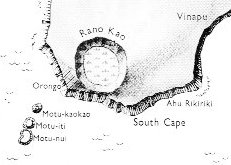
He looked
down and saw the 'Pu Mahore of Hau Maka' (on
the coast) and said, 'There it is, the hole of the mahore fish of
Hau Maka!' He turned his face and looked toward the back (i.e.,
in the direction of the crater). No sooner had he seen how the dark
abyss opened up (below him), when a fragrant breeze came drifting by.
Again Makoi said, 'This is the dark abyss of Hau Maka'.
He turned
around, walked on in utter amazement, and arrived at the house. He spoke
to Ira, 'Hey you, my friends! How forgetful we (truly) are. This
place is adequate (? tau or 'beautiful'), the dark abyss lies
there peacefully!'
Ira
replied, 'And what should that remind us of up here?' All arose and
climbed up. They went on and arrived; they all had a good look (at the
inside of the crater). They returned home and sat down. Night fell, and
they went to sleep. |
|
JUNE 7 (*78) |
8 |
9 |
10 (161) |
11 |
12 |
 |
 |
 |
 |
 |
 |
|
Ga3-19 (78) |
Ga3-20 |
Ga3-21 |
Ga3-22 |
Ga3-23 |
Ga3-24 |
|
The
Knot (Ukdah) |
Rishu
A.-13 (Head
of the Lion)
ψ Leonis (146.4),
RAS ELASET AUSTRALIS = ε Leonis
(146.6) |
VATHORZ PRIOR = υ Carinae
(147.9) |
|
Star-25 /
ANA-HEU-HEU-PO-5
(Pillar where debates were held)
ALPHARD = α Hydrae
(142.3),
ω Leonis (142.6),
τ¹
Hydrae
(142.7) |
Al Tarf-7
ψ Velorum (143.3),
ALTERF (The End)
= λ Leonis,
τ² Hydrae
(143.4), ξ Leonis (143.5) |
A Hydrae
(144.1) |
UKDAH
= ι Hydrae
(145.4),
κ Hydrae (145.5),
SUBRA = ο Leonis
(145.8) |
|
August 10 |
11 |
12 |
13 |
14 (*146) |
15 (227) |
|
°August 6 |
7 |
8 (220) |
9 |
10 |
11 (*143) |
|
'July 14 |
15 |
16 |
17 (*118 = 4
* 29½) |
18 |
19 (200) |
|
SIRIUS |
"July 1 |
2 |
3 (*104) |
4 (185) |
Anakena 5 |
|
NAKSHATRA DATES: |
|
DECEMBER 7 |
8 |
9 |
10 |
11 (345) |
12 (*266) |
|
BUNDA
(Foundation) / KAKKAB
NAMMAΧ (Star of Mighty Destiny) |
θ Piscis Austrini
(330.1), λ Oct.
(330.7) |
|
Al Sa'd al Su'ud-22 /
Emptiness-11
TSIN = 36 Capricorni
(325.2),
ALPHIRK = β Cephei
(325.7),
SADALSUD = β Aquarii,
ξ Gruis (325.9) |
no star listed
(326) |
CASTRA = ε Capricorni
(327.2),
BUNDA
= ξ Aquarii
(327.5) |
Mahar sha
hi-na Shahū-26 (Western One in the Tail
of the Goat)
NASHIRA = γ Capricorni
(328.0), ν Oct. (328.3),
AZELFAFAGE = π¹
Cygni, κ
Capricorni (328.7) |
Arkat sha
hi-na Shahū-27 (Eastern One in the Tail
of the Goat)
ENIF (the Nose) = ε Pegasi,
ERAKIS = μ Cephei
(329.2),
46
Capricorni, JIH (the Sun) = κ Pegasi
(329.3), ι Piscis Austrini (329.4), λ
Capricorni (329.6), ν Cephei (329.7),
DENEB
ALGIEDI = δ Capricorni
(329.8) |
|
February 9 (40) |
10 |
11 (407) |
12 |
13 (*329) |
All Hearts' Day |
|
°February 5 (36) |
6 |
7 |
8 (*324) |
9 (40) |
10 |
|
'January 13 (378) |
14 |
15 (*300) |
16 |
17 |
18 (383) |
|
"December 30 |
31 (*285) |
"January 1 |
2 |
3 (368) |
4 |
|
... On the fifth
day of the month of July ('Anakena'),
they all got up, went downhill, went on, and
reached Hanga Te Pau. |
The Explorers had gone uphill from Hanga Te Pau
in Maro 10 (the first day in the month of
Jus Piter, Father Light) and in Anakena 5 they
went down
again.
186 ("July 5) - 161 ("June 10) = 25 days - a Saturn
number:
|
Mercury |
Jupiter |
Venus |
Saturn |
Sun |
Moon |
Mars |
|
1 |
2 |
3 |
4 |
5 |
6 |
7 |
|
8 |
9 |
10 |
11 |
12 |
13 |
14 |
|
15 |
16 |
17 |
18 |
19 |
20 |
21 |
|
22 |
23 |
24 |
25 |
26 |
27 |
28 |
Although Makoi (Saturn) went
by himself only from "June 15 - probably because 18
* 29½ = 3 * 177 was important to be documented
in the text. A fat (pregnant) rising fish high up
under the 'roof top' illustrated his position:
|
Kuukuu |
Makoi |
|
 |
 |
|
12 *
29 |
18 * 29½ |
|
531 -
348 = 183 |
There were 24 days from ο Capricorni
to the Lucky One of the King (Al Sa'd al Malik, α Aquarii):
|
December solstice |
|
8 |
South Dipper |
φ
Sagittarii (?) |
Unicorn |
(284.0) |
Dec 30 (364) |
364 = 353
+ 11 |
|
9 |
Ox / Herd Boy |
β
Capricornii (Dabih) |
Buffalo |
(308.0) |
Jan 23 (388) |
388 = 364
+ 24 |
|
10 |
Girl |
ε Aquarii (Albali) |
Bat |
(314.8) |
Jan 29 (394) |
394 = 388
+ 6 |
| 11 |
Emptiness |
β Aquarii (Sadalsud) |
Rat |
(325.9) |
Feb 9 (405) |
405 = 394
+ 11 |
|
12 |
Rooftop |
α Aquarii (Sadalmelik) |
Swallow |
(334.6) |
Feb 18
(414) |
414 = 405
+ 9 |
From Rei in Ga2-27 (at Naos in Argo Navis) to
Sirius at Alphard in Ga3-19 (with 3 * 19 = 57
alluding to
the glyph number for Ga2-27) there were 78 (= 5 *
13) - 57 = 3 weeks:
|
MAY 14 |
15 |
16 (136
= 408 / 3) |
17 |
18 (*58) |
19 |
 |
 |
 |
 |
 |
 |
|
Ga2-24 |
Ga2-25 |
Ga2-26 |
Ga2-27 (π) |
Ga2-28
|
Ga2-29
(59) |
|
φ Gemini
(118.4) |
DRUS
= χ Carinae
(119.9) |
ω Cancri
(120.2) |
8h
(121.7)
χ
Gemini
(121.0),
NAOS
= ζ Puppis
(121.3) |
ρ Puppis (122.0),
HEAP OF
FUEL
= μ
Cancri
(122.1), ζ Monocerotis (122.3), ψ Cancri (122.6),
REGOR = γ Velorum
(122.7) |
TEGMINE
= ζ Cancri
(123.3) |
|
July 17 |
18 |
19 (200) |
20
(*121) |
21 |
22 / 7 |
|
°July
13 |
14 |
15 (196) |
16 |
17
(*118 = 4 * 29½) |
18 |
|
'June 20 |
SOLSTICE |
22 (200
- 27 = 159 + 14) |
23 |
ST JOHN'S DAY |
25 (*96) |
|
"June 6 |
7 |
8 |
9 (160) |
Maro 10 |
11 |
|
Makoi named the place Hanga
Te Pau, 'the landing site of Ira'. So
that they would remember (? he aringa,
literally, 'as face'), the open side of Hanga Te
Pau was given this name. Ira got up. They
all climbed to the top of the hill. They climbed up
on the tenth day of the month of June 'Maro'.
They reached the side crater (te
manavai) and looked around carefully.
Makoi said, 'This is the Manavai of
Hau Maka.' They climbed farther and
reached the top. They saw the dark abyss and the
large hole (of the crater Rano Kau). They all
said, 'Here it is, young men, the dark abyss of
Hau Maka.' They made camp and constructed a
house. Kuukuu got up, worked the ground, and
heaped up the earth for the yam roots. They climbed
farther and reached the top. They saw the dark abyss
and the large hole (of the crater Rano Kau).
They all said, 'Here it is, young men, the dark
abyss of Hau Maka.'
They made camp and constructed a house. |
|
...
Midsummer is the flowering season of the oak, which
is the tree of endurance and triumph, and like the
ash is said to 'court the lightning flash'. Its
roots are believed to extend as deep underground as
its branches rise in the air - Virgil mentions this
- which makes it emblematic of a god whose law runs
both in Heaven and in the Underworld ... The month,
which takes its name from Juppiter the oak-god,
begins on June 10th and ends of July 7th. Midway
comes St. John's Day, June 24th, the day on which
the oak-king was sacrificially burned alive. The
Celtic year was divided into two halves with the
second half beginning in July, apparently after a
seven-day wake, or funeral feast, in the oak-king's
honour ... |
The time of Bharani could have been important because at that ancient time (around 41 *
71 - 1842 AD = 1069 BC) Sun and Sirius would in "June 30 have been at
Alphard, at the top of the mast of Argo Navis:
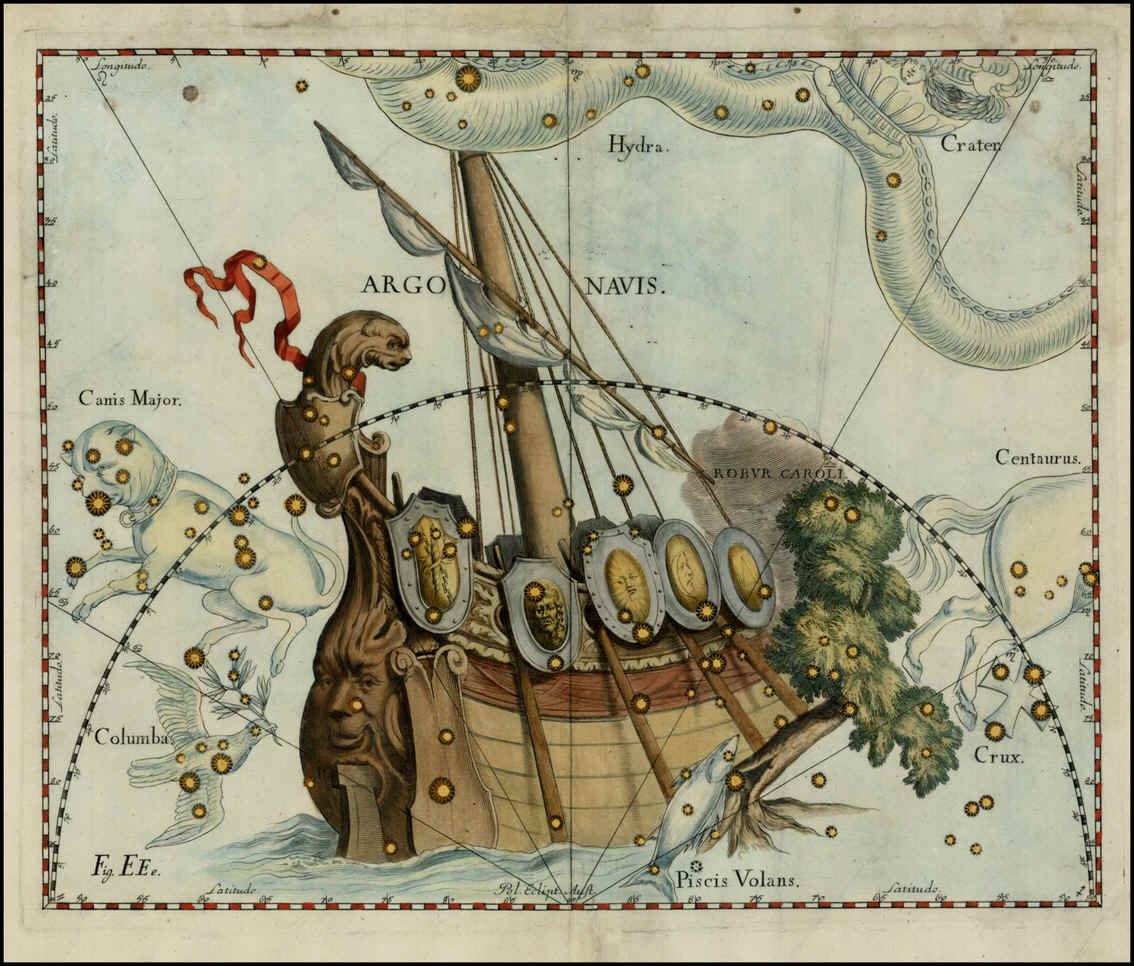
...
Etymologically the characters are
certainly connected with darkness and light respectively. The character Yin
... involves graphs for hill(shadows) and clouds; the character
Yang
has slanting sunrays or a flag fluttering in the sunshine, if indeed it does not
represent a person holding the perforated disc of jade which was the symbol of
heaven, the source of all light, and which may have been originally ... the most
ancient astronomical instrument ...
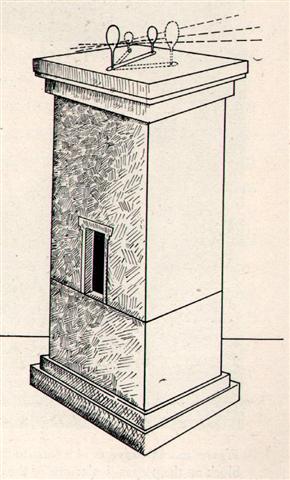 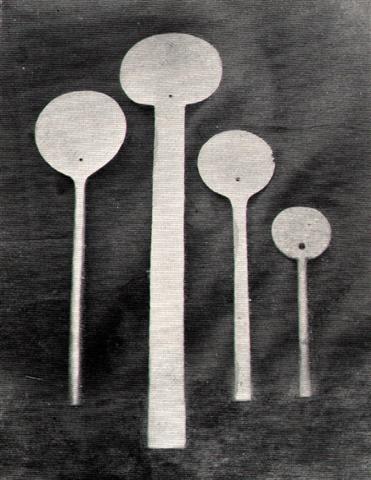
|
He
took a leathern apron, such as smiths // Wear to protect their legs
while at the forge, |
|
Stuck it upon a spear's point and forthwith // Throughout the market
dust began to rise ... |
|
He
took the lead, and many valiant men // Resorted to him; he rebelled
and went |
|
To
Faridūn. When he arrived shouts rose. // He entered the new prince's
court, who marked |
|
The
apron on the spear and hailed the omen. // He decked the apron with
brocade of Rūm |
|
Of
jewelled patterns on a golden ground, // Placed on the spear point a
full moon - a token |
|
Portending gloriously - and having draped it // With yellow, red,
and violet, he named it |
|
The
Kawian flag. Thenceforth when any Shah // Ascended to the throne,
and donned the crown, |
|
He
hung the worthless apron of the smith // With still more jewels,
sumptuous brocade, |
|
And
painted silk of Chin. It thus fell out // That Kawa's standard grew
to be a sun |
|
Amid the gloom of night, and cheered all hearts. |
This place was 4 weeks (28 glyphs = JULY 5 - JUNE 7) before the opposite
pole
where the revolution had forced the king to seek shelter high up inside his Royal Oak:
...
Robur Carolinum, Charles'
Oak, the Quercia of Italy and the Karlseiche of Germany, was
formally published by Halley in 1679 in commemoration of the Royal Oak of his
patron, Charles II, in which the king had lain hidden for twenty-four hours
after his defeat by Cromwell in the battle of Worcester, on the 3rd of September
1651 ...
|
JULY 2 |
3 (184) |
4
(*105) |
 |
 |
 |
|
Ga4-20 |
Ga4-21 (104) |
Ga4-22 |
|
11h (167.4)
χ Leonis, χ¹
Hydrae (167.1),
χ² Hydrae (167.3) |
AL SHARAS (The Rib) = β
Crateris (168.6) |
Al
Zubrah-9 /
Purva Phalguni-11
ZOSMA (Girdle) = δ
Leonis (169.2),
COXA (Hips) = θ
Leonis (169.4) |
|
September 4 |
5 (*168 = 2 * 84) |
6 |
|
°August 31 |
°September 1 (244) |
Hora Nui 2 |
|
'August 8 (*140) |
9 |
10 (222) |
| "July
25 (*126) |
26 |
Anakena 27 |
|
NAKSHATRA DATES: |
|
JANUARY 1 (366) |
2 |
3 (*288) |
|
23h (350.0)
υ, θ Gruis (350.0), π Cephei
(350.6), ι Gruis (350.9) |
SIMMAH = γ Piscium
(351.7) |
φ Aquarii
(352.0), ψ
Aquarii (352.4),
χ Aquarii
(352.6), γ Tucanae, φ Gruis (352.8) |
|
March 6 (*350) |
7 (66) |
8 (432) |
|
°March 2 (*346) |
3 |
4 (63) |
|
'February 7 |
8 (*324) |
9 (40) |
|
"January 24 |
25
(*310) |
26 |
|
JULY
5 (186) |
6
(*107) |
7 |
8 |
9 |
 |
 |
 |
 |
 |
|
Ga4-23 |
Ga4-24 |
Ga4-25 (108) |
Ga4-26 |
Ga4-27 |
|
φ
Leonis (170.0),
ALULA = ξ, ν Ursae Majoris
(170.5),
LABRUM = δ Crateris
(170.6) |
σ
Leonis (171.1), λ Crateris (171.6), ι Leonis, ε
Crateris (171.9) |
γ
Crateris, π
Centauri
(172.0), κ Crateris (172.5), τ Leonis (172.8) |
ο¹
Centauri (173.8) |
GIAUZAR = λ Draconis
(174.0), ξ Hydrae (174.3), ο² Centauri, λ
Centauri (174.8) |
|
September 7 |
8 |
9
(*172) |
10 |
11 (254) |
|
°September 3 |
4 |
5
(*168) |
6 |
7
(250) |
|
'August 11 |
12
(*144) |
13 |
14 |
15
(227) |
|
"July 28 |
29
(*130) |
30 |
31 |
'August 1 (213) |
|
NAKSHATRA DATES: |
|
JANUARY 4 |
5
(*290) |
6 |
7
(372) |
8 |
|
CROSS-BARS |
ο Gruis,
Snowball Nebula = NGC7662 Andromedae
(355.0), τ Oct. (355.3) |
no star listed (356) |
ι Phoenicis (357.3),
ι Piscium (357.4),
λ
Andromedae
(357.9) |
|
ο Cephei (353.3),
KERB
= τ Pegasi
(353.6) |
κ Piscium (354.2), θ
Piscium (354.4),
υ Pegasi
(354.9) |
|
March 9 |
10
(*354) |
11 |
12 |
13
(72) |
|
°March 5 |
6
(*350) |
7 |
8 |
9
(68) |
|
'February 10 (41) |
11 |
12 |
13
(*329) |
2-14 |
|
"January 27 |
28 |
29
(*314) |
30 |
31 |
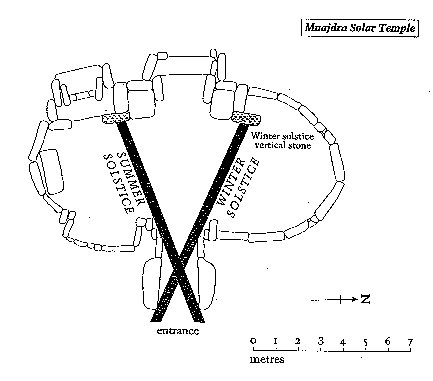
... To sleep within the
Goddess's womb was to die and to come to life anew ...
... Then I become aware of ... a
presence - a faint, ghostly glimmering, like moonglow, that has appeared on the
solstice stone. I don't know how long it lasts, a second or two only I would
guess, but while it is there it seems less like a projection - which I know it
to be - than something immanent within the stone itself. And it seems to
function as a herald for it fades almost as soon as it has appeared and in its
place the full effect snaps on - instantaneously. It wasn't there, and then it's
there. As Chris had described, the effect does curiously resemble a poleaxe, or
a flag on a pole, and consists of a 'shaft', narrow at the base but widening a
little towards the top, running up the left hand side of the solstice stone,
surmounted by a right-facing 'head' or 'flag'. An instant later an almond-shaped
spot of light, like an eye, appears a few centimeters to the right of the 'flag'
and the effect is complete. Weirdly - I do not claim it has any significance -
this flag-on-a-pole symbol
is the ancient Egyptian hieroglyph neter, meaning 'god', or 'a god' - and
not to be understood at all in the Judaeo-Christian usage of that word but
rather as a reference to one of the supernatural powers or principles that guide
and balance the universe. Manifested here, in this strange Stone Age temple, it
glows, as though lit by inner fire.'
...
During his coronation
year king Taufa'ahau Tupou IV advanced the theory that the
Ha'amonga
stones must have served a greater purpose than the more obvious function
as a gateway. This proved to be the case when closer investigation revealed a secret
mark on the lintel (threshold) stone ... On June 21st 1967 at dawn his majesty
was present at this place and it was a thrilling moment when the sun rose at the
exact point indicated by his interpretation of the lines etched on the great
stone ...
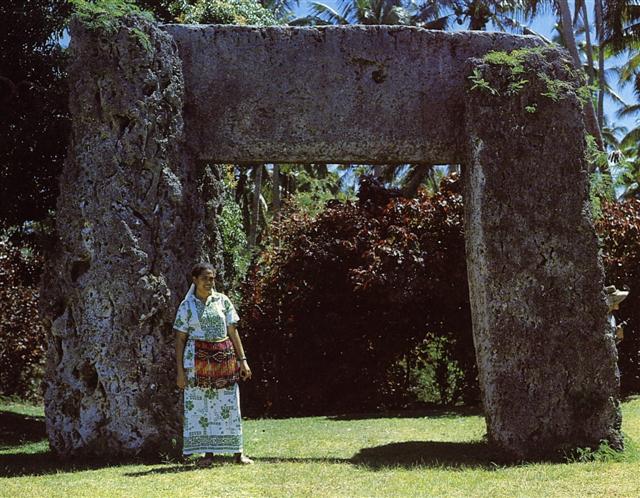
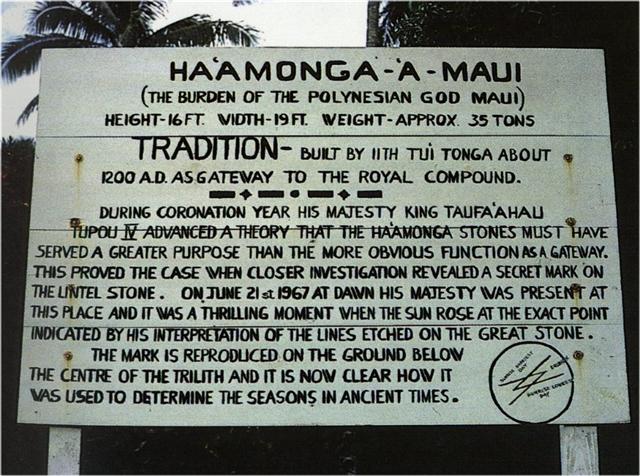
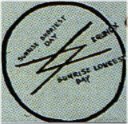
This is the flag of Mangareva (the main land of the Gambier
group) and from it we can see
the meaning of the Mayan quincunx sign - viz. how its 4 corner 'stones' were
positioned to align the central stone with the Sun at sunrise and sunset at the
solstices:
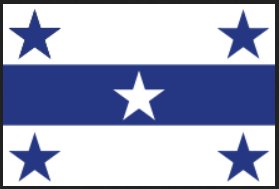

... On February 9 the Chorti Ah
K'in, 'diviners', begin the agricultural year. Both the 260-day cycle and
the solar year are used in setting dates for religious and agricultural
ceremonies, especially when those rituals fall at the same time in both
calendars. The ceremony begins when the diviners go to a sacred spring where
they choose five stones with the proper shape and color. These stones will mark
the five positions of the sacred cosmogram created by the ritual.
When the stones are brought back to
the ceremonial house, two diviners start the ritual by placing the stones on a
table in a careful pattern that reproduces the schematic of the universe. At the
same time, helpers under the table replace last year's diagram with the new one.
They believe that by placing the cosmic diagram under the base of God at the
center of the world they demonstrate that God dominates the universe.
The priests place the stones in a
very particular order. First the stone that corresponds to the sun in the
eastern, sunrise position of summer solstice is set down; then the stone
corresponding to the western, sunset position of the same solstice. This is
followed by stones representing the western, sunset position of the winter
solstice, then its eastern, sunrise position. Together these four stones form a
square. They sit at the four corners of the square just as we saw in the
Creation story from the Classic period and in the Popol Vuh. Finally, the center
stone is placed to form the ancient five-point sign modern researchers called
the
quincunx ...

... Barthel informs us that the
Maori singers in New Zealand, where the breadfruit did not grow, 'translated'
kuru (= breadfruit) in the old songs - from the times when their forefathers
lived in a warmer climate - into poporo. He points out that in the
Marquesas they counted the fruits from the breadfruit trees in fours, perhaps
thereby explaining the four 'berries' in this type of glyph. The breadfruit did
not grow on Easter Island but the berries of Solanum nigrum were eaten in
times of famine. Barthel compares with the word koporo on Mangareva. The
poor crop of breadfruits at the end of the harvest season was called
mei-koporo, where mei stood for breadfruit. On other islands
breadfruit was called kuru, except in the Marquesas which also used the
word mei. Koporo
was a species of nightshade ...
|
























